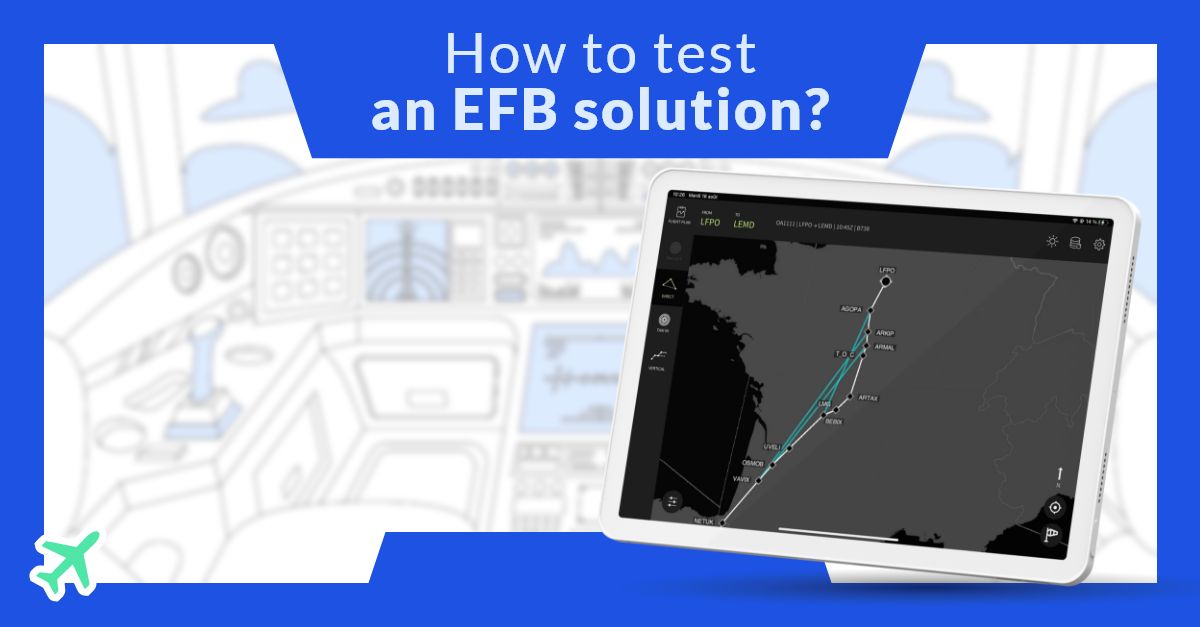How to test an Electronic Flight Bag (EFB) app in 5 steps.
As airlines continue to embrace digitalization, the use of Electronic Flight Bag (EFB) apps is providing numerous benefits. EFB apps have already become the standard for digitalizing documentation and tech logs, but now exciting new solutions are emerging in various areas of the market.
Airlines increasingly seek in-flight solutions to enhance their operations and equip pilots with advanced tools. Consequently, it is common for airlines to conduct in-flight trials to test new applications. These trials serve as an opportunity to assess the tool's suitability for the airline and the actual benefits it can bring to its operations.
Preparing for an in-flight trial requires careful planning and consideration. Here are a few essential steps to ensure a successful trial.
Step 1: Be clear with your objectives
An EFB app should bring you benefits such as simplicity, safety, and savings. As such, before researching potential providers, it is important to clearly define the objectives you want to achieve with your solution. Are you looking to increase pilots’ awareness? Lower the workload? Improve fuel efficiency?
By doing so, you can set a clear direction for the project and ensure that it aligns with your desired outcomes. For example, if you aim to improve fuel efficiency, you can explore the functionalities of an EFB app such as SkyBreathe® OnBoard, which helps pilots optimize fuel consumption by providing real-time fuel-saving recommendations.
Related content >>> Fly shorter with directs: an effective way to improve fuel efficiency
Step 2: Set KPIs to measure success
For each of these key objectives, make sure to define relevant Key Performance Indicators (KPIs) to assess if your goals are met and if the trial is a success.
If your goal is to improve fuel efficiency, measuring the fuel savings achieved during the trial is likely the most crucial metric to track. This measurement will provide the basis for estimating the impact on the entire fleet once the solution is implemented. Always make sure that you have the right tools to track your KPIs in order to reach conclusive results.
Another important factor should be to check the app's user-friendliness to ensure that it fits in with the pilot's workflow. To do so, you can plan to collect feedback directly from the crew. For example, during a recent in-flight trial of SkyBreathe® OnBoard, the airline encouraged its pilots to provide input every time they used the app, indicating whether they attempted a fuel-efficient practice and if it was achievable. Using this approach enables you to measure the tool's suitability for your operations objectively.
Step 3: Define the scope
To ensure a successful trial of the EFB app, it is important to define the scope beforehand. Follow these simple guidelines:
- Choose a period when you know you have the time to invest in such a trial. An EFB trial requires careful planning and allocation of resources. It necessitates project management expertise to coordinate all aspects, including EFB administration and the involvement of key personnel like Chief Pilots. Additionally, it's important to make sure pilots aren't juggling too many projects at once. Pilots' time and attention are valuable, and focusing on the EFB trial without distractions is crucial for its success.
- The trial period should be long enough to reflect your operations and get enough feedback to be usable. Depending on your operations, the nature of the app, and the trial's objectives, it can vary from 2 weeks to 2 months. The goal is, as mentioned above, to generate enough data to be able to compute what you want to measure.
- Depending on the app, you can choose a sector to focus on, an airport, or an aircraft type. It can help to limit the investment needed for the trial. However, remember that for an EFB trial to be conclusive - especially if your goal is to improve fuel efficiency - a substantial volume of data and a broad enough scope are necessary to measure results and draw conclusions regarding the savings that have been achieved.
By following these guidelines, you can ensure a well-defined scope for your EFB app trial and maximize its effectiveness in improving your operations.
Step 4: Engage your pilots
Pilots are the final users of EFB apps. During the trial and after deployment, they should be at the forefront of the app's usage. Their engagement is a priority.
To make the most of the trial, the best way is to ask motivated pilots to test a new app. In some airlines, those pilots are already identified and form a group of “test pilots” that are used to test and trial different apps. If you are not there yet and know that different trials are upcoming, it may be the way to go. Communicate with your pilots and find those eager to beta-test new apps. Without the support of the test pilots, there is a risk that the trial will not go as planned.
Related content >>> How to better engage pilots?
The second point, of course, is to train pilots. Even experienced participants in such campaigns require thorough training. It's important to address the "why, what, and how" questions:
- Why are you testing this app, and why is it important?
- What specific features will they be testing, and what is expected of them?
- How will the test be conducted, and how does the app function?
Finding time to train pilots can be challenging, so we recommend providing an auto-training option that pilots can use at their convenience. For example, you can:
- Create a video tutorial that records a user journey to introduce pilots to the app.
- Write a reference guide for the pilots that covers the user journey and provides explanations for each step.
- Provide timely support to the pilot, either through direct communication with the supplier (e.g., via the app) or by connecting with designated personnel within the airline's offices involved in the trial. This is to address any issues promptly and keep them engaged.
- Connect your pilots with "power users". For example, you can designate a user champion among the pilots who receive advanced training and can assist their colleagues.
Step 5: Run a trial phase and post-trial evaluation
During the trial, it is crucial to have an efficient follow-up: pay attention to the questions asked by your pilots, as the sooner it is answered, the smoother it will be. Consider feedback, address issues, ensure tool usage, and take necessary actions to maintain control of the trial. There might be some changes to be made or different configurations to test. This requires cooperation from both the airline and the supplier. A strong relationship and responsiveness are key ingredients to keep up pilot engagement.
Once the trial is complete, it is time to reflect on the objectives you set out to achieve. Evaluate your metrics and compare them to your initial goals. Gathering additional feedback from pilots who tested the app or conducting interviews can greatly enhance your understanding of the trial's outcomes and pave the way for further improvements.
In short...
Successful EFB solution trials require clear objectives, the ability to measure results, well-defined scopes, engaged pilots, and flexibility throughout the trial process. Post-trial evaluations, based on performance metrics and pilot feedback, serve as the foundation for making informed decisions on selecting the right solution for your airline. As the aviation industry continues to embrace digitalization, effective EFB solution testing is key to reaping the benefits of advanced technologies to improve your operations.
If you want to discuss this further, don't hesitate to contact one of our fuel experts or come and meet us in person at the upcoming EFB Users Forum in Prague on November 7-9!
LEARN MORE
To go further in learning about eco-flying techniques and getting pilots more involved in your fuel efficiency program, check out the e-learning: "Fuel efficiency basics: an introduction to pilot's eco-flying techniques".



